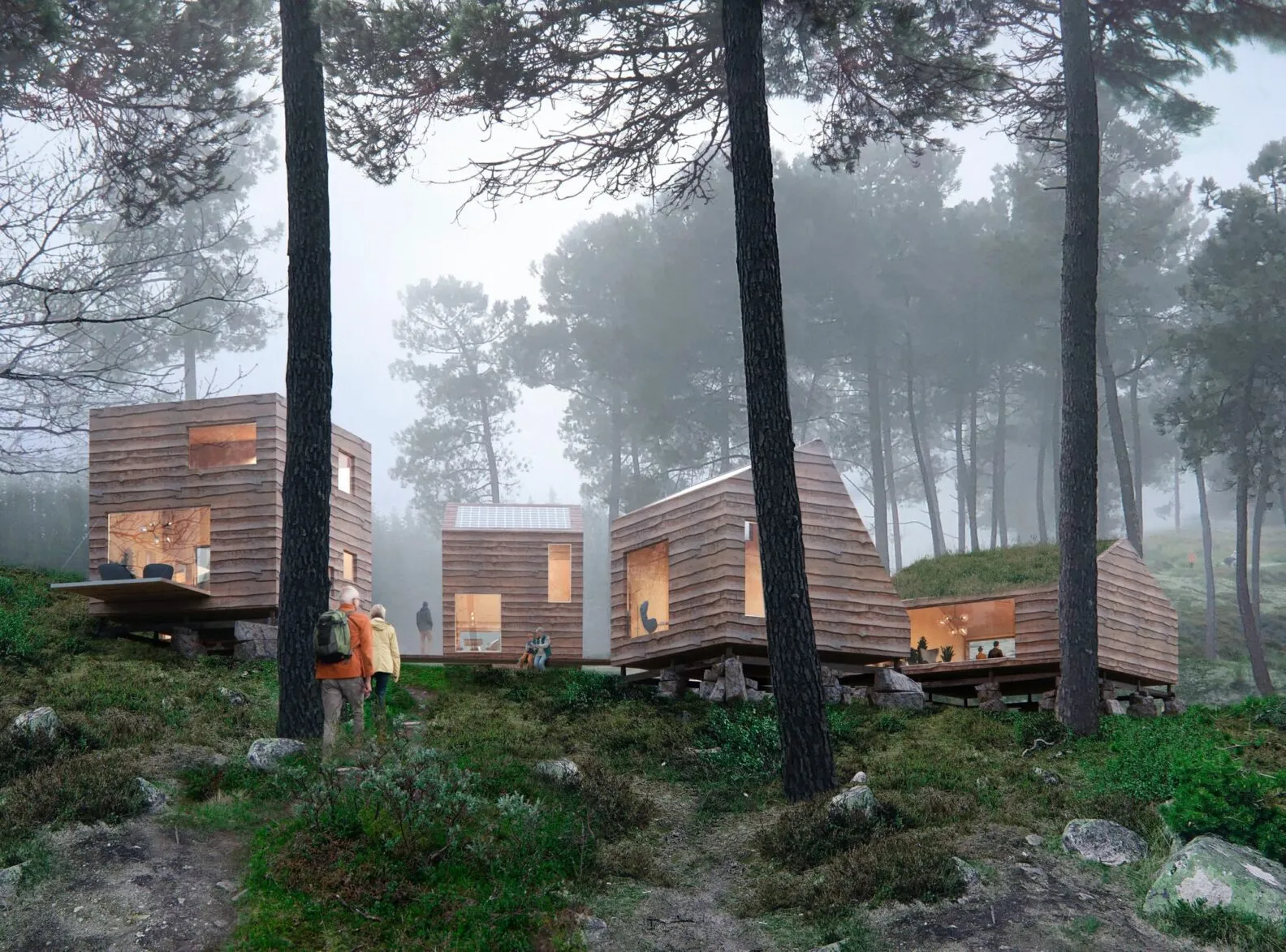Is it possible to build cottages without ruining nature? The new concept TraceLess by Snøhetta draws inspiration from old construction techniques and available technical solutions for off-grid cabins. The concept has a low climate footprint and leaves no lasting traces in the terrain, hence the name TraceLess.
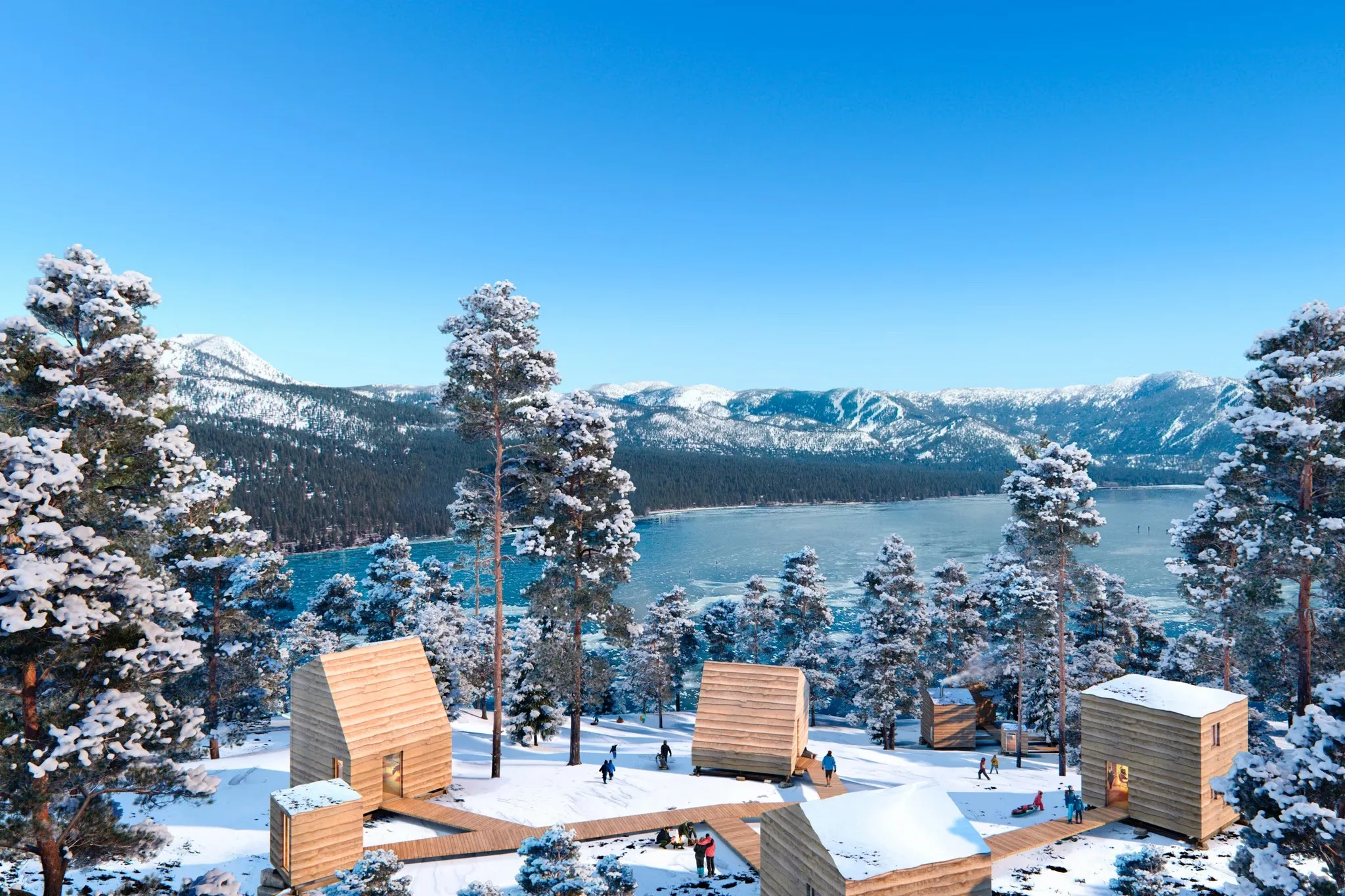
The first pilot, consisting of two clusters with four cottages and a technical unit, is planned near the popular recreation area Otrosåsen at Hovden in Setesdal, Norway. The cabins are placed on piled stones and connected by a network of footbridges raised above the terrain with the necessary infrastructure, such as water and electricity, underneath. By using carefully placed footbridges and traditional piled stone fundaments, permanent changes to the landscape are avoided.
The clusters act like micro ecosystems harvesting electricity and heat from the sun and water from the rain. The residents must live on nature’s premises and not the other way around. Another important part of the concept is accessibility. The rental cottages are universally designed, allowing a broad range of visitors to experience living close to nature. In addition, the technical solutions are already proven solutions that are available in the Norwegian market. In other words, a TraceLess cottage is something you can draw inspiration from and build yourself.
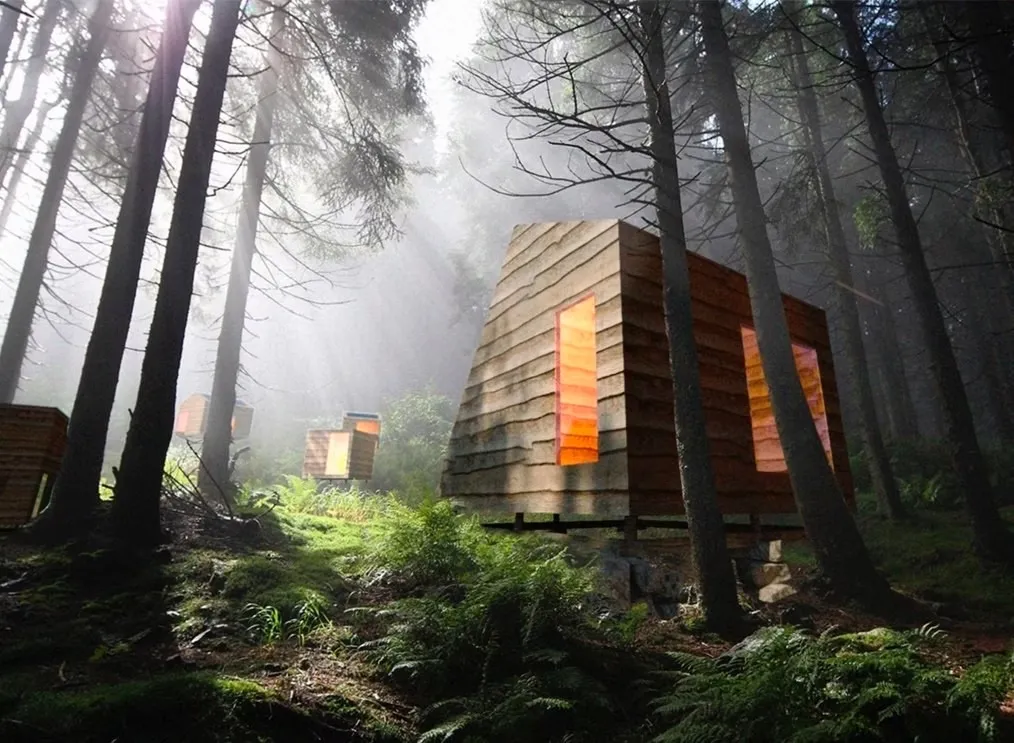
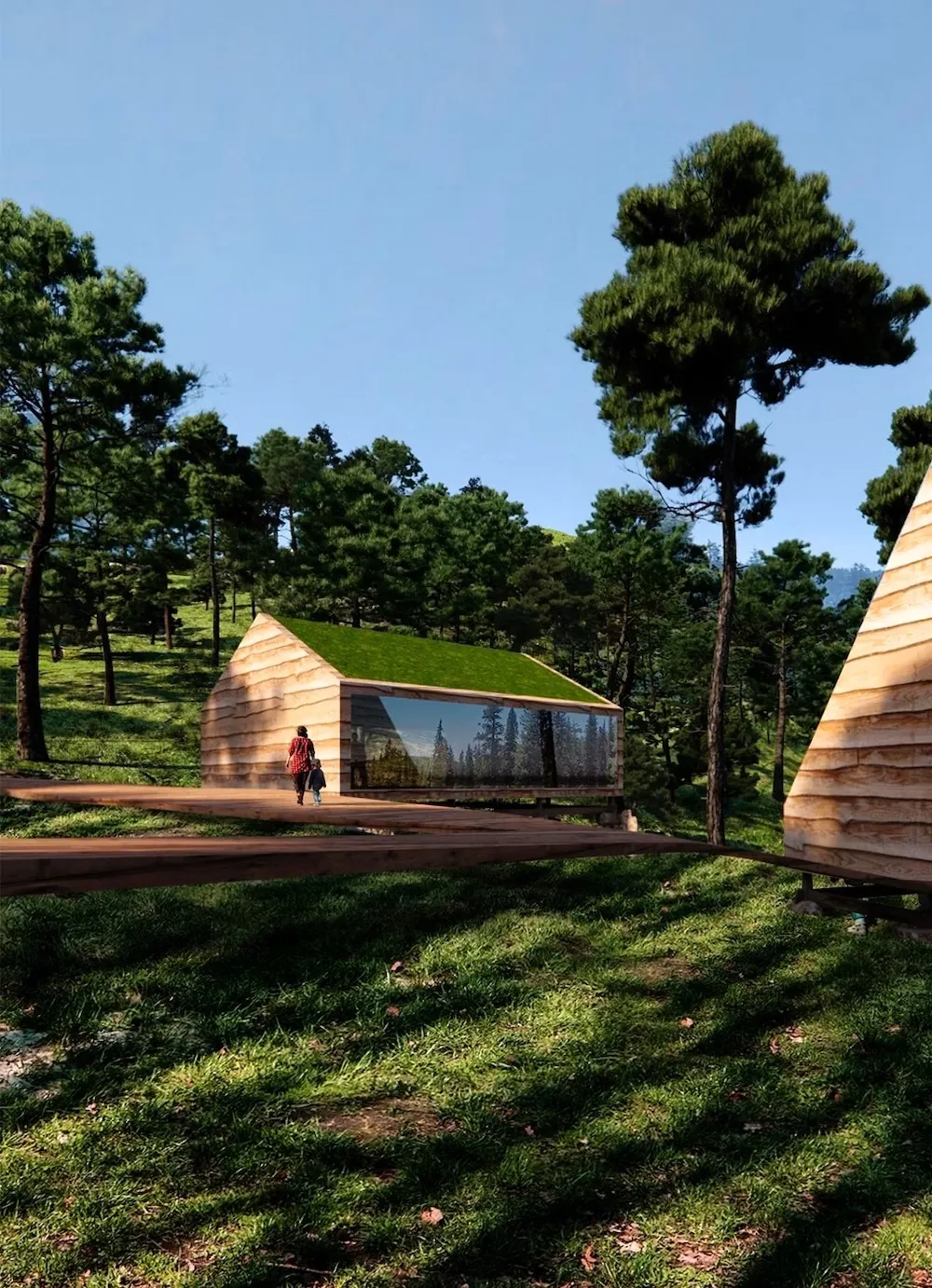
Staying at the cabin during the weekend, and spending time in nature is a tradition many Norwegian values. There are close to half a million cabins in Norway. And there is a limit to how many new cabins the ecosystem can tolerate with the associated infrastructure. The usual construction method is blasting the area to make a foundation, which creates wounds in the landscape and affects biological diversity. In addition, material use, transport of materials and services, and heating leave an unnecessarily high climate footprint. The TraceLess pilot explores alternative forms of development that balance the symbiosis between man and nature and promote collective experiences. Therefore, the TraceLess concept is founded on three pillars of sustainability: Economic cooperation, social conditions, and climate and environment.
Using pile stones is a several-hundred-year-old local building technique used to construct traditional Norwegian storage houses, without blasting out the terrain. Materials are sourced and crafted locally and based on reuse and leftovers from the wood industry.
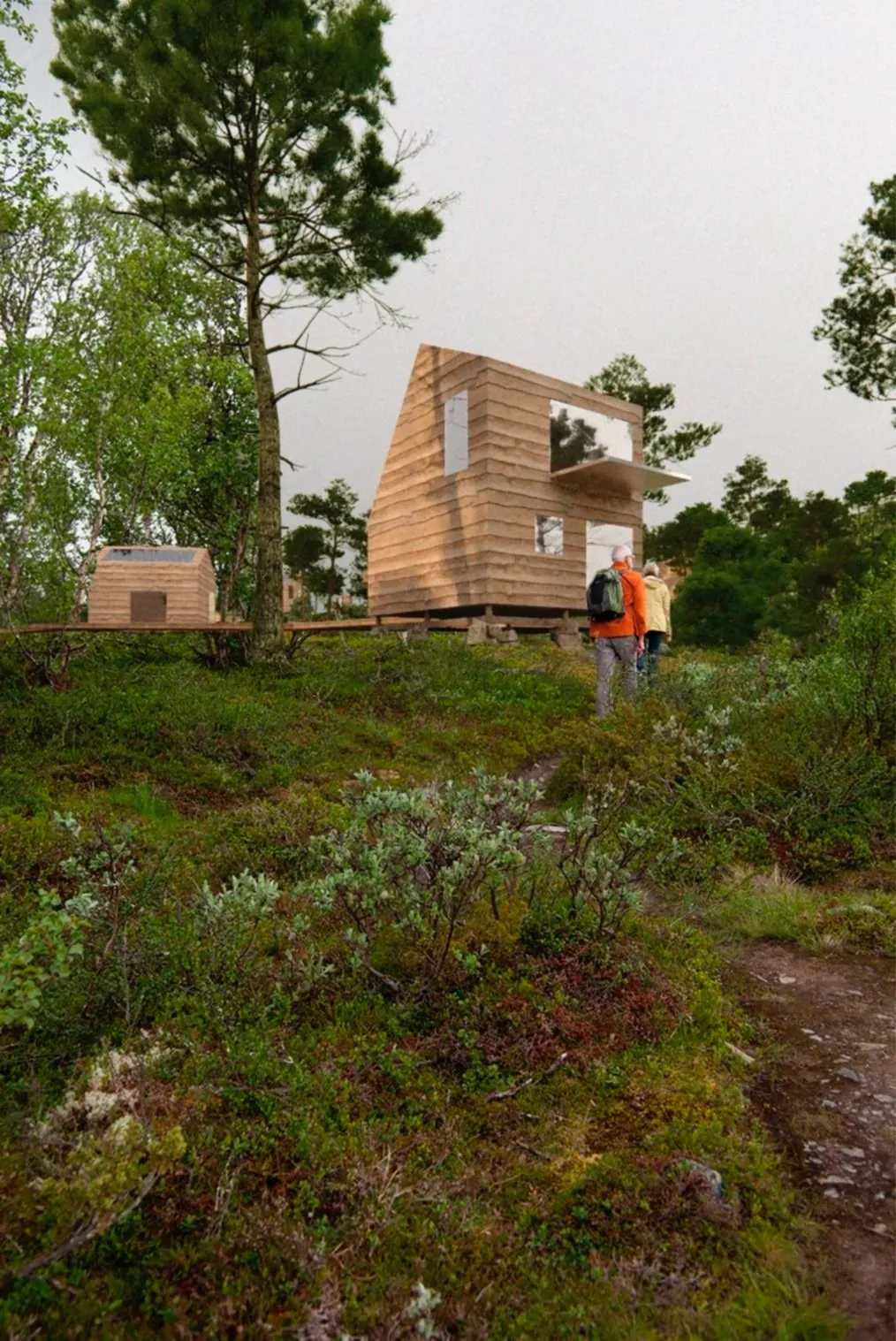
The compact 6 x 6 meters cottages can accommodate up to five people each and are designed with elementary needs in mind: A place to be together, sleep, wash, and share meals. The layouts are inspired by traditional hunting and fishing huts and are available in two variants. Both are designed with the social aspect in mind and are named Åre and Ete (Norwegian for eating) after the pleasures of joining for a meal. In the Åre cottage sleeping areas are centered around a low hearth, while Ete places the dining table in the center. Togetherness is also central to the design of the outdoor areas. The footbridges weave the outdoor space together and invite you to play and spend time together.
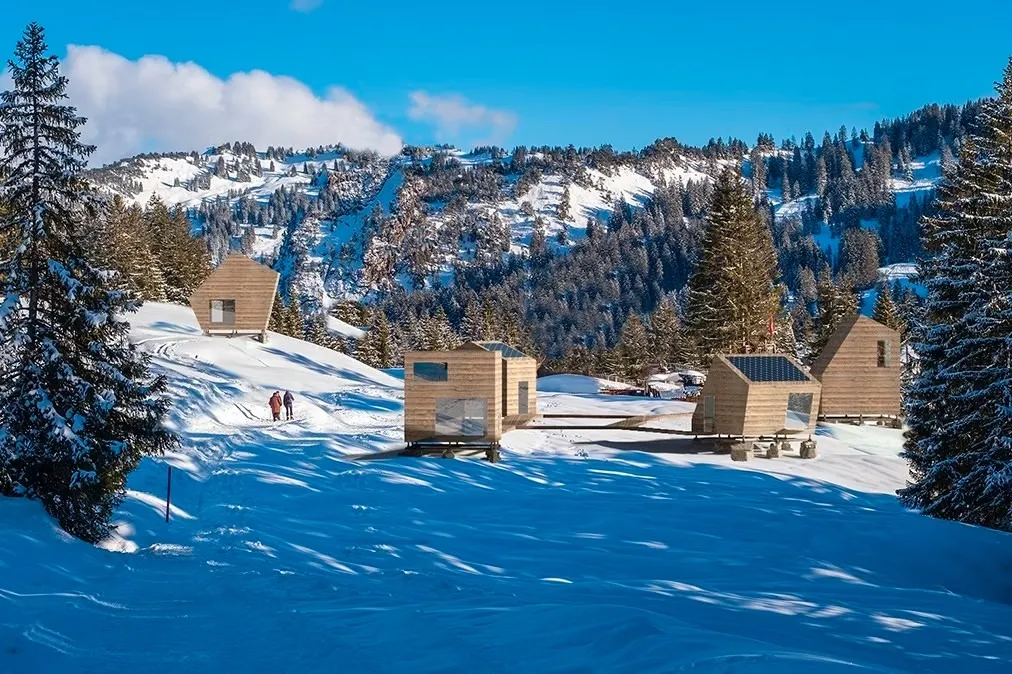
Sun and rain are harvested on the roofs, making the cottages self-sufficient with water, heat, and electricity. The technical solutions focus on placements and systems that do not leave permanent marks on the terrain with buried tanks, piping, or infiltration ditches. These solutions affect the lifestyle and use of the cabins. Due to limited access to water and electricity, residents must continuously keep aware of their consumption. Such knowledge is gained of how simple actions, like reducing water consumption and using more environmentally friendly soaps, can make a positive impact on the environment without affecting the quality of the experience.
On the technical side water consumption is kept down by using water-saving systems. Water from showers and hand washing is cleaned and recycled into gray water. The toilets’ vacuum system is a hygienic solution that uses a minimum of water compared to traditional water closets.
Each cottage is equipped with a combined PV and solar collector system, which converts the energy from the sun into heat and electricity. Harvested heat is used to keep the cabins warm and tap water hot. By running the system in a cycle, the roof panels are kept warm ensuring melted snow filling water tanks during the winter.
Contact: Mari Grinde Arntzen
Market Communication Advisor
mariga@snohetta.com
Typologies
Destination, Recreation, Sustainability
Status
Design Proposal
Location
Hovden, Norway
Client
Sætersdalen AS
Collaborators
Structor Vann AS
Size
Cottages: 400 m2, footbridges: 40 m2
https://snohetta.com/news
Photo: Snøhetta/Ramka
More news from Snøhetta:

MATTER — a new woven language rooted in randomness
From Code to Carpet: Snøhetta and Ege Carpets introduce MATTER — a new woven language …
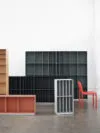
A shelving system sculpting space through light, form, and movement by Snøhetta
A shelving system sculpting space through light, form, and movement In collaboration with BD Barcelona …

Come and discover the Array modular sofa system, designed by Snøhetta – MDF Italia
Array is a sofa system designed by Snøhetta to offer maximum flexibility and comfort. It’s …

Vesterheim Commons wins IES Illumination Award of Merit – Snøhetta
Vesterheim Commons has been awarded an IES Illumination Award of Merit for its meritorious contribution …

Snøhetta is Guest of Honour 2026 @ Stockholm Furniture Fair
As Stockholm Furniture Fair celebrates its 75th anniversary in 2026, the fair looks both backward …

Waves of Innovation: Snøhetta and Nola’s Våg Bike Shelter Redefines Public Space
Waves of Courage and Change The bike shed Våg was born from a site-specific project at the …

Aura Collection: Snøhetta x Viabizzuno = Shaping the Invisible
Aura Collection: Snøhetta x Viabizzuno Shaping the Invisible: A Luminous Evolution The Aura Collection marks …

Joslyn Art Museum - A redesign for Omaha’s premier cultural hub for the visual arts by Snøhetta
Photo: Nic Lehoux After a closure of two years, The Joslyn Art Museum reopens today …

Snøhetta created an “ecological playscape” along Seoul’s dormant Banpo waterfront
Snøhetta went to the final round in the international design competition of Banpo-Hangang River Connection …
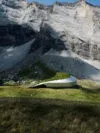
540 Square Meters of Harmony: Modern Architecture Embraces UNESCO Heritage by Snøhetta
Snøhetta announces Refuge de Barroude A safe haven for hikers in the Pyrenees Nestling in …

Čoarvemátta: New Hub Blends Sami Culture with Traditional Architecture by Snøhetta, together with 70°N architecture & artist Joar Nango
New cultural and educational hub Čoarvemátta draws inspiration from Sami heritage and traditional building customs …

Snøhetta unveils a peaceful sanctuary overlooking Japan’s famous Mount Yotei
Photo by: Mir. Rusutsu, Japan—Snøhetta has designed a new model for a vacation home nestled …

Vertikal Nydalen by Snøhetta wins Storebrand Eiendom’s sustainability award
The award was presented on Tuesday, August 13, during an event aboard the Storebrand RS, …

Snøhetta explores the textures of terracotta in a new tile collection with Fornace Brioni
In a second collaboration with Italian ceramic tile manufacturer Fornace Brioni, Snøhetta explores terracotta as …
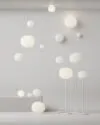
Snøhetta has extended the Volum collection with four new floor variants – Lodes
Snøhetta extends Volum series for Lodes As a continuation of the successful collaboration with Italian …
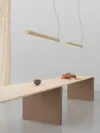
SuperDuperTube from hemp to lamp design by Snøhetta – ateljé Lyktan
From hemp to lamp More than just an evolution of our classic luminaire, the Supertube, …

TraceLess Innovative cottages with low footprint by Snøhetta
Is it possible to build cottages without ruining nature? The new concept TraceLess by Snøhetta …

Snøhetta & Vipp unveils nest-like cabins on the edge of Lysefjorden
Snøhetta has been working with local entrepreneur Tom Bjarte Norland and Danish interior brand Vipp …

Snøhetta designs urban farm in the heart of Hong Kong
Snøhetta has designed three clubhouses for The Pavilia Farm residential development, creating a calming green …
Westchester Square Library Will be Snøhetta’s Latest Project with the New York City Department of Design & Construction
Last week, Snøhetta, the New York City Department of Design and Construction, and the New …

A new public Garden and a repositioned landmark debut in Midtown Manhattan by Snøhetta
A new public Garden and a repositioned landmark debut in Midtown Manhattan This week Olayan …

Snøhetta designs stars for the Norwegian Cancer Society’s 10th anniversary Christmas Star Campaign
Every Christmas, the Norwegian Cancer Society raises money for lifesaving cancer research through their Christmas …

Snøhetta Summit seating system for +Halle
Summit Modules Every so often a new piece of furniture is created, adhering to principles …

Snøhetta has designed its very first lamp collection Svit – ateljé Lyktan
A piece of Scandinavian nature Snøhetta has designed its very first lamp collection, Svit, in …

Perspektivenweg by Snøhetta Wins Dezeen Awards’ Landscape Project of the Year by Public Vote
We are excited to announce that our Path of Perspectives project, Perspektivenweg, has been named …

Casework collection is growing by Snøhetta – Erik Jørgensen
The Casework collection, a collection revolving around sustainable thinking, created in collaboration with Norwegian architecture …

Casework by Snøhetta – Erik Jørgensen
Sustainability, Minimalism, Customisable. This became the refrain in the process of creating the furniture pieces …

Architecture and Landscape in Norway
Finissage of the exhibition “Architecture and Landscape in Norway – Photographs by Ken Schluchtmann” with …

Europe’s very first underwater restaurant “under” by Snøhetta
At the southernmost point of the Norwegian coastline by the village of Båly, Snøhetta has …

Snøhetta – Ryerson wins 2017 Toronto Urban Design Award
The Ryerson University Student Learning Centre has been selected for a 2017 Toronto Urban Design …

Snøhetta heads for completion in Saudi
Featuring an auditorium, library, cinema, exhibition hall and museum this centre for World Culture will …

Snøhetta completes landscape design for MAX IV Laboratory
Since 2011, Snøhetta has been working on the development of a unique landscape design for …

Snøhetta has won a competition to design the new Banque Libano Francaise
Snøhetta to design Banque Libano Francaise’s new headquarters Snøhetta has won the competition to design …

New San Francisco Museum of Modern Art designed by Snøhetta
The transformed and expanded San Francisco Museum of Modern Art (SFMOMA) opens to the public …

Snøhetta and OMA to Stockholm Design Talks
Stockholm Furniture & Light Fair’s own forum for knowledge and discussions in the area of …

7 Cool Architects, a chair and few rules – Fritz Hansen
When Fritz Hansen invited 7 internationally well-known architects to interpret the Series 7™ into new …

Snøhetta @ Danish Architecture Centre 2015
19 June 2015 – 27 September 2015 The summer of 2015 the Danish Architecture Centre …

Våg bicycle roof by Snøhetta Architects – nola
Våg (Wave) is a new, modern bicycle roof in fiberglass, developed new MAX IV Laboratory …

